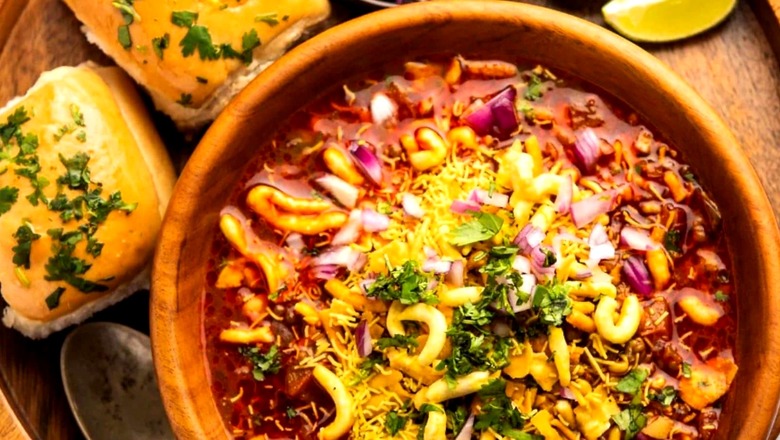
views
I started my circuit from Kolhapur, travelled down coastal Maharashtra to the seafood paradise of Vengurla, and Malvan and the beaches of Tarkarli. Then up to Nasik, an ancient city on the banks of the Godavari River known for its links to the Ramayana. Then to the Vidarbh on the Deccan Plateau, deep into central India and eastern Maharashtra, to taste the robust food of Amravati and Nagpur. Along the way, the flavours have been astonishing, the use of spices extraordinary, and the tastes unanticipated. So, I thought I’d talk about the three best meals, I’ve had so far in my journey.
Starting with Kolhapur and its inimitable ‘Misal’. Each part of Maharashtra has their own version of Misal. But the Kolhapuri Misal is a time bomb about to explode. It is a fiery mix of sev, chivda, papadi and usal. The farsaan-usal mix is topped with Kat, which is what gives this misal personality and fire. Kat is a like red-hot fiery rasam made with dry coconut, onions, tomatoes, ginger, garlic, coriander and cumin, garam masala, hing and lots of oil. Garnished with just a little knob of curd, grated coconut, chopped raw onion and coriander, this Kolhapuri Misal is served with box pav which is nothing more than slices of sandwich bread. A really good Kolhapuri Misal should combust in your mouth while exploding through your, nose and eyes. Dynamite!
A full Kolhapur meal itself is a tryst of flavours. Starting with a variety of ‘Rassas’ – a thin often spicy coconut curry. There are at least 14 kinds of ‘Rassas’ in Kolhapur. Tambda, Pandhra, Pivla, Hirva Kala Rassa (red, white, yellow, green black) to name a few. A classical Kolhapuri meal consists of a portion of Tambad Rassa (an intensely tempestuous red gravy with a tarri floating on top), and Pandhra Rassa (a delicately spiced, white, buttery gravy of coconut and garam masala), which is served with Kolhapur’s famous Mutton Loncha or Pickle. Soft and tender mutton fried in oil, then cooked with dry coconut, ginger, garlic, poppy seeds, sesame seeds, red chilli powder, turmeric and Kanda-Lasun Masala.
Moving to the Vidarbha. Before we start salivating over the food in Nagpur, which is dominated by the legend and stardom of Saoji cuisine, I’d like to take you to Vidarbha’s main cuisine, Varhadi, and to the second largest city in the region, Amravati.
While Saoji cuisine is obsessed with all the parts goat; the staple at a Varhadi or Vidarbha home, however, is a little less occupied with meat, and more engrossed with a menu of spicy vegetarian foods, that are made with Besan. Starting with what has now become Maharashtra’s staple food, the everyday ‘Pithla Bhakri’. Besan mixed with water and turmeric is poured into a tadka of mustard seeds, cumin, hing, curry leaves and green garlic chili paste. This is eaten with Jowar Bhakri, raw onion and Varhadi Thecha (pounded chillies).
Unlike other Maharashtrian Thechas, the Varhadi Thecha is made from red chillies, garlic and an arsenal of spices. Daily home food could be Patodi Rassa (besan cakes in spicy gravy), Zunka (besan cooked and tempered with onions, mustard, ginger garlic), Puran Poli with lots of ghee poured and Gola Bhaat rice cooked with spiced besan balls, served with Tamarind Saar and maybe curd on the side.
The use of so much besan is because the Vidarbha is one of the hottest places in the country and has little rain. And since vegetables were so difficult to grow, lentils became a substitute.
In Nagpur, however, the most well-known cuisine is Saoji. The Saojis were an old community of traditional handloom weavers. As the demand for their silks and cottons declined, and men lost their livelihood, the women of the community, all expert cooks, worked on turning their culinary skills and their home cuisine into a thriving business. Saoji is the name of their community. The most iconic Saoji dish is the ‘Varhadi Rassa’ which could be made from nearly every part of the goat, the meat, kidney, the liver, brain and trotters, as well as intestines. It’s all dark reddish-brown, very hot and spicy. The spice, heat and colour in the food, come from a lot of black pepper and chillies. A favourite snack at any Saoji Restaurant is Khur Sukka (paya or trotters), Kapoora Sukka (sweet bread) Gurda Sukka (kidney) and even Lamb innards. I had a teary eyed, albeit euphoric meal at one such Saoji restaurant in Kolhapur. Oh what a meal!
But all these different regions of the vast state of Maharashtra have one food in common — Simple Varan Bhat and Toop (ghee) — the best meal in the world for a true Maharashtrian. The Sadha Varan (dal made from lentils) with steamed rice and topped with ghee. This is a dish that takes you home.
Kunal Vijayakar is a food writer based in Mumbai. He tweets @kunalvijayakar and can be followed on Instagram @kunalvijayakar. His YouTube channel is called Khaane Mein Kya Hai. The views expressed in this article are those of the author and do not represent the stand of this publication.
Read all the Latest Lifestyle News here

















Comments
0 comment